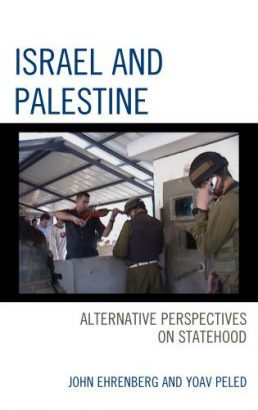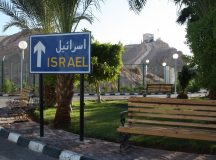It is extraordinary that 70 years after the UN partition resolution we are still discussing the future of the territory that was at the time British Mandate Palestine. However, as this collection demonstrates, the options put forward in 1947, by Jews and Arabs and by the UN, remain, remarkably, much the same. The chapters of the book offer us a single unitary state, two distinct states, shared sovereignty and two states but with shared institutions. All of these options were on the table in the l940’s and it was the UN Special Commission on Palestine that narrowed the options to two: a federal state or two states within an economic union. As we know, the latter was eventually adopted by the UN General Assembly in resolution 181 in November 1947.
Self-determination and Cooperation
It is significant that the most exciting chapters in this collection return to that partition resolution and offer contemporary versions of it, addressing the specific features of the Palestinian-Israeli situation and propose both self-determination and cooperation. Micheline Ishay and David Kretzmer ground their argument for ‘reclaiming human rights’ within both Israeli and Palestinian discourses. They point out that many of the key texts of both peoples make human rights central. They accept that there are many challenges in going beyond a formal acceptance of human rights to a new political dispensation. However, they argue that a ‘confederative model based on the centrality of human rights’ (89) offers a realistic chance of a solution. Rassem Khamaisi argues for a similar outcome suggesting that there is one country but should be two states. In her thoughtful piece, she sees the necessity for ‘geopolitical separation and division but functional cooperation and coordination’ (180). Lev Luis Grinberg also suggests that a political union for two nation states has possibilities. However, unlike some other contributors, he is concerned about the mechanisms needed to arrive at a solution, quoting the conflict resolution theorist Arend Lijphart who claims that the preconditions for negotiations require both trust and incentives. How these can be engendered is not discussed.
Oren Yiftachel offers the most rounded argument for a solution that is based on the conception of a single homeland but two sovereign states. He approaches the nature of the conflict between Israelis and Palestinians with great subtlety and a keen awareness of history. He argues that the ‘Zionist-Palestinian conflict is both a clash between colonisers and indigenous peoples and between two nations battling over the same territory’ (311). He points out that until 1947 this was ‘colonisation by refugees’ (312). The one-state supporters frequently suggest that the tide of history is against the national state. However, as Yiftachel says, the record of unifications is meager compared to the disintegration of states. As he says, ‘why should the first such unification occur in Israel/Palestine?’ – especially ‘given their recent historical trauma’ (319). ‘It is hard to imagine,’ he continues, ‘any nation giving up its sovereign power, let alone Israeli Jews acting in this way’ (319).
He then turns to the position frequently advanced by one-state proponents that the pattern of Israeli settlements in the West Bank has destroyed the possibility of a Palestinian state and makes one-state inevitable. Yiftachel says that this argument is ‘built on an ethnocentric mind set, which assumes a priori that every area on which Jews reside will remain under Jewish sovereignty, that every Jew must continue to live under Israeli rule. This mind set fits well with the assumptions of the Israeli colonial regime in the occupied territories, but contradicts the long experience of liberal democracies, where minorities live among a majority having a different culture’ (320). He refers to a 2013 B’Tselem report which finds that the built-up areas of the settlements amount to only 2 per cent of the West Bank land. Yiftachel, a professor of political geography comments, ‘despite the attempts of settlers and their supporters to destroy the Palestinian national space, the situation is not irreversible’ (320). He also makes the point that there are ethical, legal and human rights considerations that those advancing the one-state ignore, as they are arguing for the dissolution of an existing state. In addition he writes, ‘Israel is not “just another” state but a political entity created by and for refugees after massive genocide against the Jews’ (322).
Yiftachel then advances his vision of the future which is an endorsement of the One Homeland/Two States programme. This envisages the creation of a sovereign Palestinian state based on the 1967 borders alongside Israel but with the creation of some common institutions to coordinate issues such as security, the economy and the environment. Its centrepiece will be a Court to guarantee the human rights of citizens in each state. The programme advocates that, eventually, there would be open borders and free movement between the two states, and that Jerusalem would be united and the capital of both states. As he points out, this is a contemporary version of the 1947 UN partition plan which sought to create two states, one Jewish and one Arab but within an economic union and with Jerusalem under international control. While this plan was accepted by the Zionist movement at the time, it was rejected by the Palestinians and the Arab world. However, there have been major changes in the last 70 years. It is now the case that both sides have not only accepted the partition plan, but incorporated it into foundational texts. It appears both in the Israeli Declaration of Independence in 1948 and in the Palestinian Declaration of Independence of 1988. Yiftachel knows that such a proposal ‘sounds utopian’. However, he sees it as offering a space which could be ‘postcolonial and democratic’ where Israel and Palestine ‘will be able to advance toward decolonisation and real reconciliation’ (332). His chapter offers us a proposal that is both ethical and practical, emerging out of the conditions of life experienced by both peoples and addressed top their aspirations.
The rest of the book is somewhat unruly, perhaps inevitably as 19 authors have contributed 17 chapters on topics ranging from the attitudes of American Jews to Israel (Richard Silverstein) to an assessment of the Geneva Initiative (Yoav Kapshuk) to a highly theoretical piece on sovereignty (Amal Jamal). This is compounded by the less than systematic organisation of the book. The apparent simplicity of an extended overview followed by two sections, one on the two-state solution and the other on the one-state option is belied by the inclusion of chapters arguing for quite different positions than the section headings would suggest. (For example, the devastating critique of the one-state model by Oren Yiftachel appears in the very section headed ‘The One-State Alternative’.)
The book originated in a 2011 conference organised by the Political Science Department of Tel Aviv University. The proceedings were published in Hebrew in the department’s journal The Public Sphere. The current volume mainly contains updated and re-written papers. The contributors are drawn from scholars who teach at universities based in US, Israel and Palestine, many of whom are also known for their activism. However, perhaps it is in its unruly nature that the book’s virtue lies. Like getting to know a new city, getting lost is strangely helpful. In this case, the book’s disorientating properties provokes the reader to thinking creatively about the conflict.
That is not to say that some of the arguments are not perplexing. In the opening section, Ian S. Lustick tackles the thorny question of title to territory. He argues that for such claims to be valid they must meet four requirements: they should be universal, trans-historical, that all groups should benefit from the claim and that the claim can be implemented. The idea that claims can be trans-historical stems from his belief that national claims to land only date from seventeenth century (24). This tendentious view seems particularly odd, in the context of a discussion of Israel given that the Torah is essentially a story of how the Jews, seen as nation, come to dwell in their land. If his tests were to be applied internationally no state would remain intact. It is precisely history that has created states and their territorial delimitations; and it must be said this was mainly the result of conquest, colonialism (not just European) and war. The boundaries of Palestine in 1920 and of Israel in 1949 were no exception to this pattern. Nonetheless, this rather disruptive intervention reminds us that there is a school of thought that constructs Palestine, Israel and the conflict outside of history. Lustick’s idea that there are rational grounds for the distribution of territory in Palestine-Israel would be regarded as absurd if applied in the Americas. It is helpful to be reminded of this approach which so often diverts attention from dealing with realities on the ground. On the other hand, the book also contains some gems of analysis. For example, Honaida Ghanim describes the situation in the West Bank as both temporary occupation and permanent colonialism, this she names a ‘situation of permanent temporariness’ (97).
The volume’s purpose is to focus attention on the alternative forms in which a state could emerge from a resolution to the conflict. Assaf Sharon makes the case for the two-state solution which is based around the need for the separation of two peoples who simply cannot live together. He argues that the one-state solution is utopian and warns against making false comparisons with countries such as Canada, the UK or Belgium. He points that many multi-national states have recently fallen apart, as in the case of Yugoslavia through devastating wars. He is alive to the obstacle of settlements but points out that they are mainly dormitory towns with two-thirds of settlers holding jobs on the Israeli side of the Green Line. His most convincing argument is that only a Palestinian state will end occupation ‘dismantling the oppressive system of control that has been in place since 1967’ (129). As he points out the two-state solution has never been tried and remains the most realistic outcome.
Raef Zreik offers the utopian conception of the one-state option that Sharon rejects. He sees it as a ‘radical solution – a single state of equals,’ (238) drawing on Virginia Tilley’s work and reflecting its abstract and ahistorical approach to the conflict. He argues that the conflict is moving from the ‘Algerian model to the South African one’ (225). Palestinians and Israelis are thus not seen as constituting specific political communities, which have been shaped by particular histories but are constructed as lifeless categories. For Zreik, self-determination is a precept of the past. In his account the two nations have been dissolved into millions of individuals who must now demand their rights as citizens in a single state. Leila Farsakh, in her chapter also supporting the one-state position, does attempt to address the difficult problem of resituating ‘the Palestinian struggle for self-determination within a “rights” paradigm’ (203). She acknowledges that this would mean a drastic revision of the Palestinian national programme. Despite being alive to the issue she still insists that the struggle for equal rights in one state will break the current stalemate without any evidence to support this proposition. Indeed, no Palestinian national movement, including Fatah and Hamas, has turned its back on that the goal of self-determination.
To the contrary, the 2012 UN recognition of Palestine as a non-member state has been widely seen as one of the few diplomatic successes for the Palestinians. It is a gain that will not be given up. Farsakh, however, argues that there is much to learn from the struggle against South African apartheid, ‘in terms of discourse as much as in strategy’ (218). She entirely ignores the differences between the history and politics of South Africa and Israel. The former was founded as a single state in 1910 on the basis of a racially discriminatory system. From its origins, the excluded majority population opposed its racist basis and fought for citizenship. From the creation of the African National Congress in 1912 until the first free elections in 1994 there were eight decades of struggle for equality and inclusion. It is simply impossible to transplant South African political consciousness to Israelis and Palestinians. In any event, the international community opposed apartheid and supported a unified democratic non-racial South Africa, whereas the UN has regularly reaffirmed the right of Israelis and Palestinians to self-determination.
Moshe Behar argues that the idea of a Jewish state in Palestine has always had a one-state logic. In his account of the 1919-1923 period he suggests that the Zionist delegation to the Peace Conference headed by Chaim Weizmann proposed a map of a large Jewish territory that included both banks of the Jordan Valley. ‘It is not coincidental,’ he comments, 100 years later, ‘that the map brings to mind Israel’s most militant ultra-Zionist settlers’ (245). The message is clear, there is single line which links the liberal Weizmann to the most right-wing settlers – Zionism is Zionism. What he fails to mention is that the map was part of the Arab-Zionist agreement that Weizmann had negotiated with the Hashemite, Prince Faisal. While he implies that the area would be the ‘proposed territory for a Jewish state,’ it was in fact the delimitations of where Jews could immigrate. However, this chapter is worthy of study as the debate about annexation of the West Bank grows in Israeli government. While we may question his interpretation of historical events, it is undoubtedly the case many on the Zionist Right would draw the same conclusions. He is highly pessimistic, seeing the future as be characterised by ‘ethnic cleansing’ or a ‘deeper ethnocracy’.
Waiting is no longer an option
In his now famous press conference with Israeli Prime Minister Benjamin Netanyahu, US President Donald Trump announced that ‘I’m looking at two-states or one-state, and I like the one both parties like. I can live with either one’. Many commentators assumed that this signalled the end of the US support for a two-state solution, adopted during George W. Bush’s administration. However, the real story is that Trump was in fact pressing Netanyahu to make up his mind. And pressure from the White House is not what Netanyahu wants. His political career has been based on an opportunist pragmatism which has no place for end games. Keeping people guessing has been the key to his political success thus far. By keeping his options open he has the flexibility to build coalitions across Israeli politics. Every existing coalition can be replaced by another which helps discipline partners keen to hold office and entices the opposition at the same time. The result is that Netanyahu remains Prime Minister. However, Netanyahu now faces a difficult moment. Proposals from within his cabinet to annex some or all the West Bank are difficult to ignore. Defence Minister Avigdor Lieberman has suggested that the Trump administration has already ruled out supporting that. However, those in the Israeli government who want to annex some or all the West Bank hope to pre-empt the US administration. They see this as the political moment to implement their version of the one-state solution. The one-state proponents in this collection should note that far from leading to civil rights for all, it would relegate the Palestinians to a permanent subservient status. Netanyahu can continue his balancing act because of a similar political view in Ramallah where President Mahmoud Abbas seems trapped by competing factions in Fatah – and by Hamas – into a static diplomacy. However, the Palestinian leadership could turn their apparent weakness into a strength by taking a simple initiative that would be entirely new. It should publish a map of a Palestinian state alongside Israel and propose its implementation in the spirit of the UN partition plan. This could transform the situation. John Ehrenberg writes in his conclusion to this book: ‘Convinced that the problem cannot be resolved, both sides sit tight and wait. For what is not clear.’ (369) In 2017, the political situation is changing and waiting is no longer an easy option.





































‘It is simply impossible to transplant South African political consciousness to Israelis and Palestinians.’
Didn’t we hear over and over how impossible a ‘unified democratic non-racial South Africa’ would be before apartheid ended?